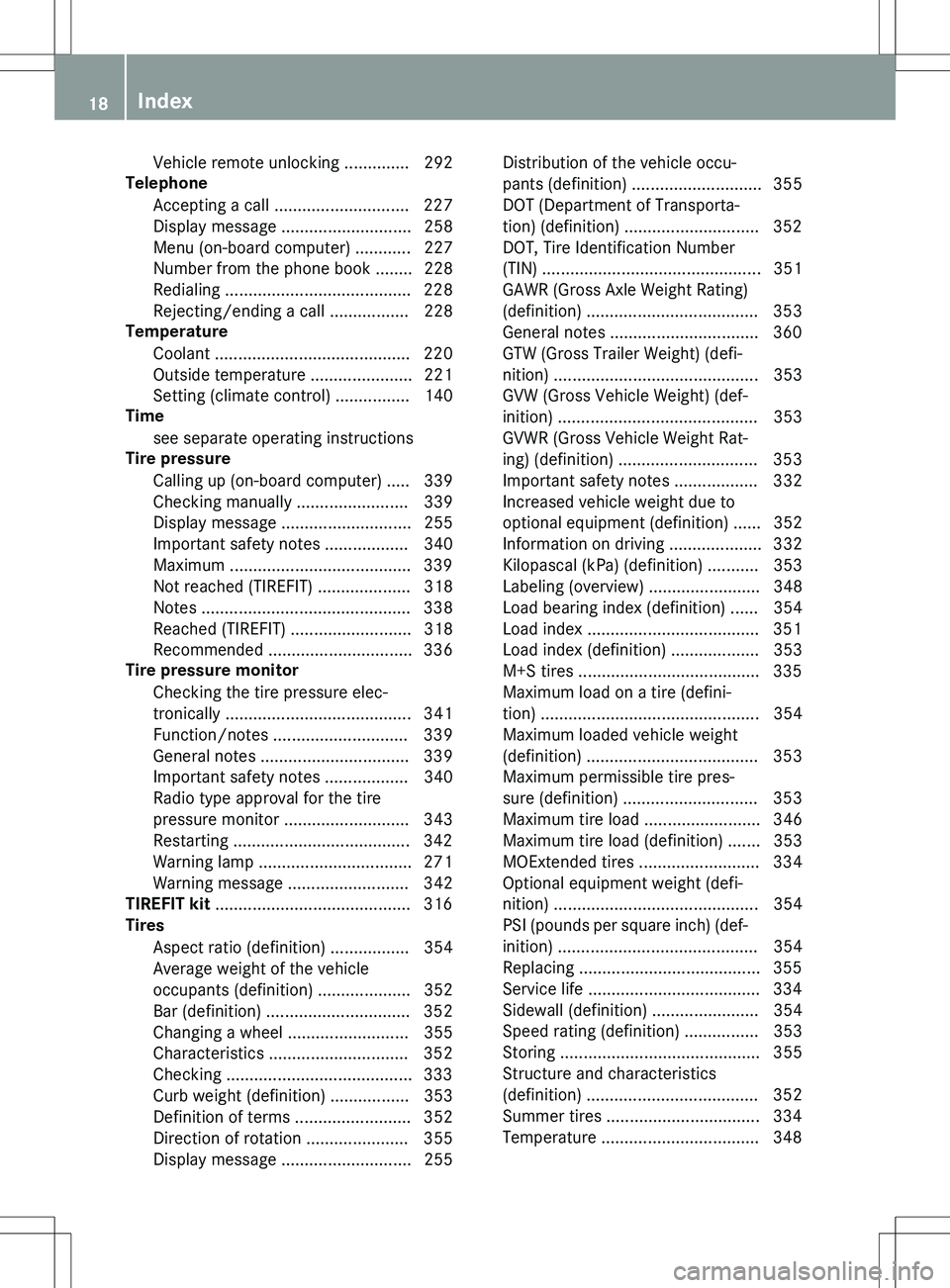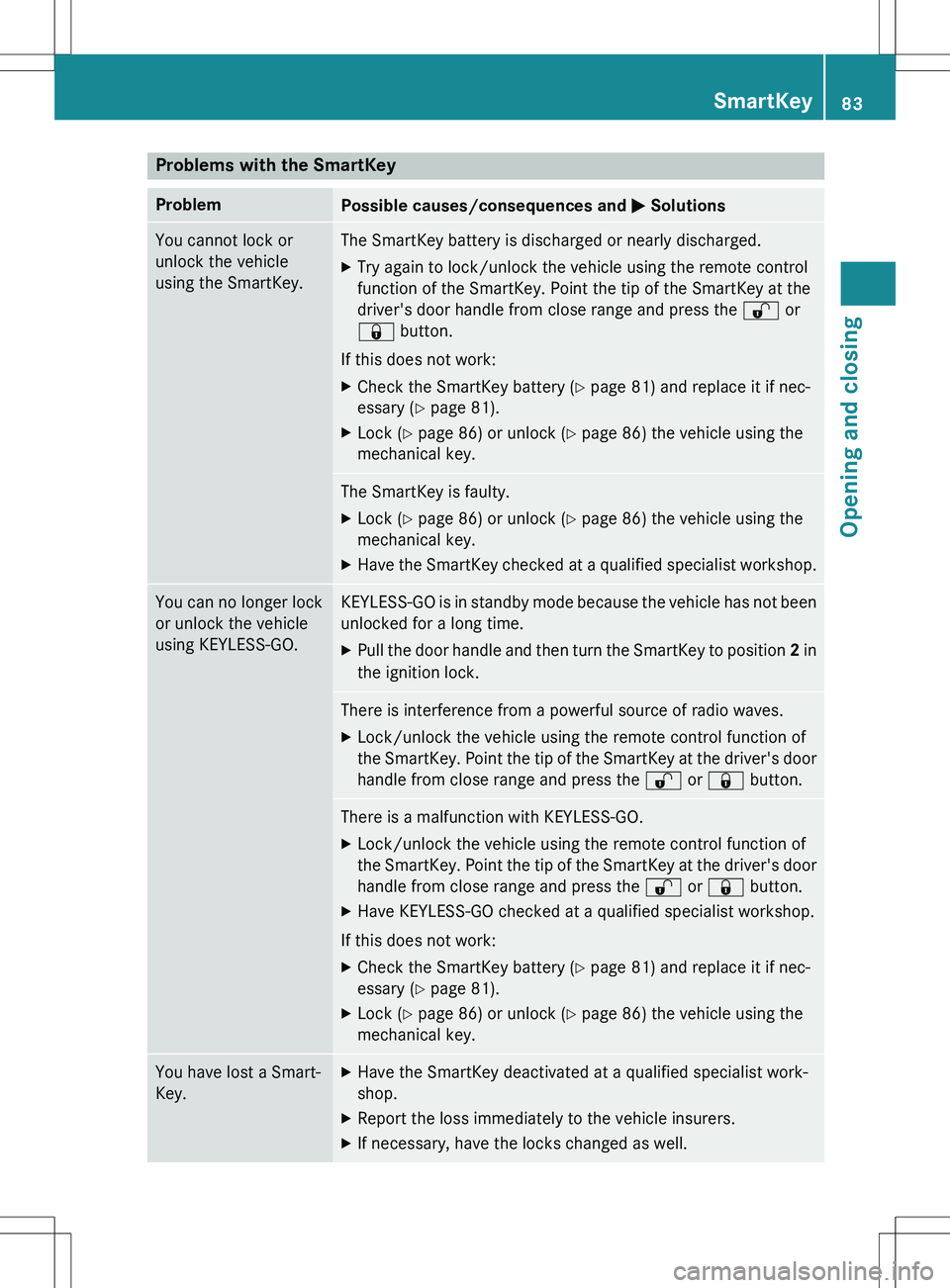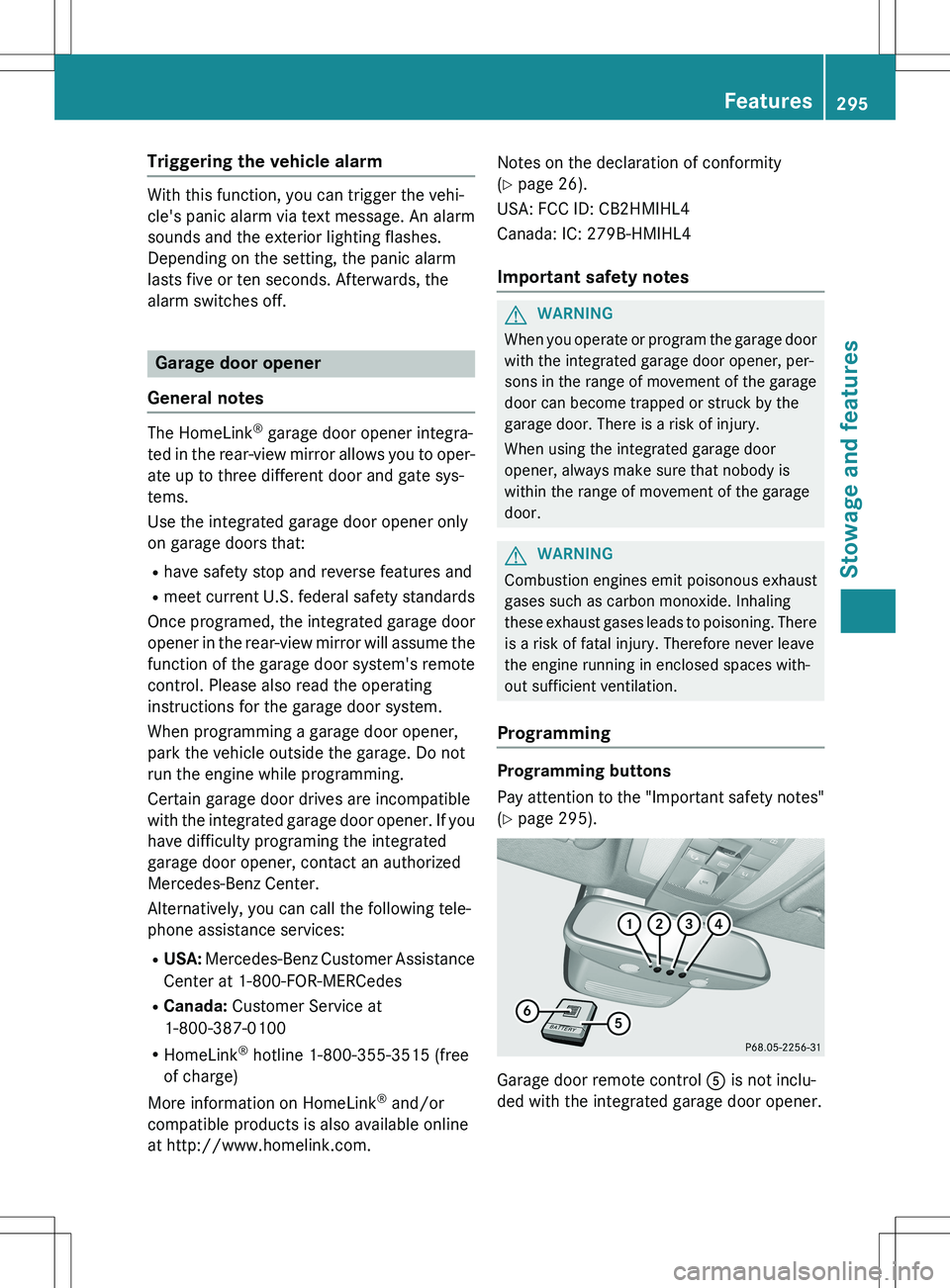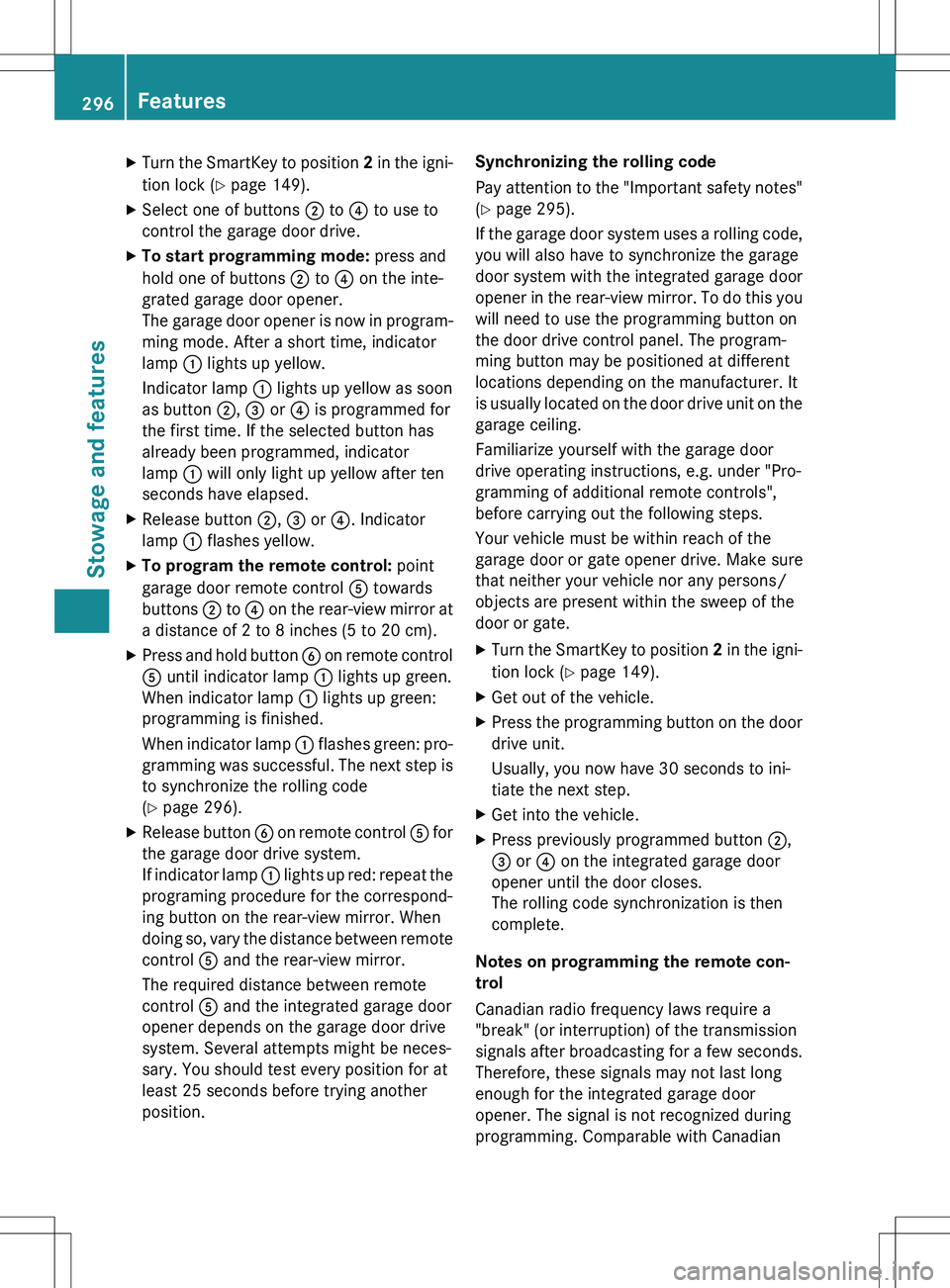2015 MERCEDES-BENZ GLK-CLASS SUV remote control
[x] Cancel search: remote controlPage 17 of 386

Immobilizer ...................................... 74
Protection of the environment
General notes .................................. 22
Pulling away
Automatic transmission ................. 152
Q
QR codeMercedes-Benz Guide App ................. 1
Rescue card ..................................... 28
Qualified specialist workshop ........... 27
R
Radar sensor system
Activating/deactivating ................. 233
Display message ............................ 250
Radio
Selecting a station ......................... 226
see separate operating instructions
Radio-wave reception/transmis-
sion in the vehicle
Declaration of conformity ................ 26
Reading lamp ..................................... 121
Rear compartment
Setting the air vents ...................... 145
Setting the airflow ......................... 141
Rear fog lamp
Display message ............................ 245
Switching on/off ........................... 118
Rear view camera
Cleaning instructions ..................... 309
Function/notes ............................. 193
Switching on/off ........................... 194
Rear window defroster
Problem (malfunction) ................... 143
Switching on/off ........................... 142
Rear window wiper
Replacing the wiper blade .............. 128
Switching on/off ........................... 127
Rear-view mirror
Anti-glare (manual) ........................ 109
Dipping (automatic) ....................... 110
Refrigerant (air-conditioning sys-
tem)
Important safety notes .................. 379
Refueling
Fuel gauge ....................................... 33 Important safety notes .................. 162
Refueling process .......................... 163
see Fuel
Remote control
Garage door opener ....................... 295
Programming (garage door
opener) .......................................... 29 5
Replacing bulbs
Important safety notes .................. 122
Overview of bulb types .................. 123
Reporting safety defects .................... 27
Rescue card ......................................... 28
Reserve (fuel tank)
see Fuel
Reserve fuel
Display message ............................ 248
Warning lamp ................................. 267
see Fuel
Residual heat (climate control) ........ 143
Reversing feature
Panorama sliding sunroof ................ 95
Roller sunblinds ............................... 96
Side windows ................................... 92
Tailgate ........................................... . 87
Roadside Assistance (breakdown) .... 24
Roller blind
see Roller sunblind
Roller sunblind
Opening/closing .............................. 97
Panorama roof with power tilt/
sliding panel ..................................... 96
Roof carrier ........................................ 281
Roof lining and carpets (cleaning
guidelines) ......................................... 312
Roof load (maximum) ........................ 380
Route (navigation)
see Route guidance (navigation)
Route guidance (navigation) ............ 225
S
Safety
Child restraint systems .................... 61
Children in the vehicle ..................... 61
Occupant Classification System
(OCS) ............................................... 49
Overview of occupant safety sys-
tems ................................................ 42
Index15
Page 20 of 386

Vehicle remote unlocking .............. 292
Telephone
Accepting a call ............................. 227
Display message ............................ 258
Menu (on-board computer) ............ 227
Number from the phone book ........ 228
Redialing ........................................ 22 8
Rejecting/ending a call ................. 228
Temperature
Coolant .......................................... 22 0
Outside temperature ...................... 221
Setting (climate control) ................ 140
Time
see separate operating instructions
Tire pressure
Calling up (on-board computer) ..... 339
Checking manually ........................ 339
Display message ............................ 255
Important safety notes .................. 340
Maximum ....................................... 339
Not reached (TIREFIT) .................... 318
Notes ............................................. 33 8
Reached (TIREFIT) .......................... 318
Recommended ............................... 336
Tire pressure monitor
Checking the tire pressure elec-
tronically ........................................ 3 41
Function/notes ............................. 339
General notes ................................ 339
Important safety notes .................. 340
Radio type approval for the tire
pressure monitor ........................... 343
Restarting ...................................... 342
Warning lamp ................................. 271
Warning message .......................... 342
TIREFIT kit .......................................... 316
Tires
Aspect ratio (definition) ................. 354
Average weight of the vehicle
occupants (definition) .................... 352
Bar (definition) ............................... 352
Changing a wheel .......................... 355
Characteristics .............................. 352
Checking ........................................ 333
Curb weight (definition) ................. 353
Definition of terms ......................... 352
Direction of rotation ...................... 355
Display message ............................ 255 Distribution of the vehicle occu-
pants (definition) ............................ 355
DOT (Department of Transporta-
tion) (definition) ............................. 352
DOT, Tire Identification Number
(TIN) ..............................................
. 351
GAWR (Gross Axle Weight Rating)
(definition) ..................................... 35 3
General notes ................................ 360
GTW (Gross Trailer Weight) (defi-
nition) ............................................ 353
GVW (Gross Vehicle Weight) (def-
inition) ........................................... 353
GVWR (Gross Vehicle Weight Rat-
ing) (definition) .............................. 353
Important safety notes .................. 332
Increased vehicle weight due to
optional equipment (definition) ...... 352
Information on driving .................... 332
Kilopascal (kPa) (definition) ........... 353
Labeling (overview) ........................ 348
Load bearing index (definition) ...... 354
Load index ..................................... 351
Load index (definition) ................... 353
M+S tires ....................................... 335
Maximum load on a tire (defini-
tion) .............................................. . 354
Maximum loaded vehicle weight
(definition) ..................................... 35 3
Maximum permissible tire pres-
sure (definition) ............................. 353
Maximum tire load ......................... 346
Maximum tire load (definition) ....... 353
MOExtended tires .......................... 334
Optional equipment weight (defi-
nition) ............................................ 354
PSI (pounds per square inch) (def-
inition) ........................................... 354
Replacing ....................................... 355
Service life ..................................... 334
Sidewall (definition) ....................... 354
Speed rating (definition) ................ 353
Storing ........................................... 3 55
Structure and characteristics
(definition) ..................................... 35 2
Summer tires ................................. 334
Temperature .................................. 348
18Index
Page 80 of 386

Useful information
iThis Operator's Manual describes all
models and all standard and optional equip- ment of your vehicle available at the time of
publication of the Operator's Manual.
Country-specific differences are possible.
Please note that your vehicle may not be
equipped with all features described. This
also applies to safety-related systems and
functions.
iRead the information on qualified special-
ist workshops ( Y page 27).
SmartKey
Important safety notes
GWARNING
If children are left unsupervised in the vehicle,
they could:
R open the doors, thus endangering other
people or road users.
R get out and disrupt traffic.
R operate the vehicle's equipment.
Additionally, children could set the vehicle in
motion if, for example, they:
R release the parking brake.
R shifting the automatic transmission out of
park position P
R Start the engine.
There is a risk of an accident and injury.
When leaving the vehicle, always take the
SmartKey with you and lock the vehicle. Never
leave children or animals unattended in the
vehicle. Always keep the SmartKey out of
reach of children.
GWARNING
If persons, particularly children are subjected to prolonged exposure to extreme heat or
cold, there is a risk of injury, possibly even
fatal. Never leave children unattended in the
vehicle.
GWARNING
If you attach heavy or large objects to the
SmartKey, the SmartKey could be uninten-
tionally turned in the ignition lock. This could
cause the engine to be switched off. There is arisk of an accident.
Do not attach any heavy or large objects to the
SmartKey. Remove any bulky key rings before
inserting the SmartKey into the ignition lock.
! Keep the SmartKey away from strong
magnetic fields. Otherwise, the remote
control function could be affected.
Strong magnetic fields can occur in the
vicinity of powerful electrical installations.
R Do not keep the KEYLESS-GO key:
- with electronic devices, e.g. a mobile
phone or another SmartKey
- with metallic objects, e.g. coins or metal
foil
- inside metallic objects e.g. a metal case
This can affect the functionality of the
SmartKey.
SmartKey functions
The SmartKey centrally locks/unlocks:
R the doors
R the tailgate
R the fuel filler flap
:& To lock the vehicle
;F To open/close the tailgate
=% To unlock the vehicle
78SmartKey
Opening and closing
Page 85 of 386

Problems with the SmartKey
ProblemPossible causes/consequences and M Solutions
You cannot lock or
unlock the vehicle
using the SmartKey.The SmartKey battery is discharged or nearly discharged.
X Try again to lock/unlock the vehicle using the remote control
function of the SmartKey. Point the tip of the SmartKey at the
driver's door handle from close range and press the % or
& button.
If this does not work:
X Check the SmartKey battery ( Y page 81) and replace it if nec-
essary ( Y page 81).
X Lock ( Y page 86) or unlock ( Y page 86) the vehicle using the
mechanical key.
The SmartKey is faulty.
X Lock ( Y page 86) or unlock ( Y page 86) the vehicle using the
mechanical key.
X Have the SmartKey checked at a qualified specialist wor kshop.
You can no longer lock
or unlock the vehicle
using KEYLESS-GO.KEYLESS-GO is in standby mode because the vehicle has not b een
unlocked for a long time.
X Pull the door handle and then turn the SmartKey to posit ion 2 in
the ignition lock.
There is interference from a powerful source of radio waves.
X Lock/unlock the vehicle using the remote control function of
the SmartKey. Point the tip of the SmartKey at the driv er's door
handle from close range and press the % or & button.
There is a malfunction with KEYLESS-GO. X
Lock/unlock the vehicle using the remote control function of
the SmartKey. Point the tip of the SmartKey at the driv er's door
handle from close range and press the % or & button.
X Have KEYLESS-GO checked at a qualified specialist workshop.
If this does not work:
X Check the SmartKey battery ( Y page 81) and replace it if nec-
essary ( Y page 81).
X Lock ( Y page 86) or unlock ( Y page 86) the vehicle using the
mechanical key.
You have lost a Smart-
Key.X Have the SmartKey deactivated at a qualified specialist work-
shop.
X Report the loss immediately to the vehicle insurers.
X If necessary, have the locks changed as well.
SmartKey83
Opening and closing
Z
Page 297 of 386

Triggering the vehicle alarm
With this function, you can trigger the vehi-
cle's panic alarm via text message. An alarm
sounds and the exterior lighting flashes.
Depending on the setting, the panic alarm
lasts five or ten seconds. Afterwards, the
alarm switches off.
Garage door opener
General notes
The HomeLink ®
garage door opener integra-
ted in the rear-view mirror allows you to oper-
ate up to three different door and gate sys-
tems.
Use the integrated garage door opener only
on garage doors that:
R have safety stop and reverse features and
R meet current U.S. federal safety standards
Once programed, the integrated garage door opener in the rear-view mirror will assume the
function of the garage door system's remote
control. Please also read the operating
instructions for the garage door system.
When programming a garage door opener,
park the vehicle outside the garage. Do not
run the engine while programming.
Certain garage door drives are incompatible
with the integrated garage door opener. If you
have difficulty programing the integrated
garage door opener, contact an authorized
Mercedes-Benz Center.
Alternatively, you can call the following tele-
phone assistance services:
R USA: Mercedes-Benz Customer Assistance
Center at 1-800-FOR-MERCedes
R Canada: Customer Service at
1-800-387-0100
R HomeLink ®
hotline 1-800-355-3515 (free
of charge)
More information on HomeLink ®
and/or
compatible products is also available online
at http://www.homelink.com. Notes on the declaration of conformity
(
Y page 26).
USA: FCC ID: CB2HMIHL4
Canada: IC: 279B-HMIHL4
Important safety notes
GWARNING
When you operate or program the garage door with the integrated garage door opener, per-
sons in the range of movement of the garage
door can become trapped or struck by the
garage door. There is a risk of injury.
When using the integrated garage door
opener, always make sure that nobody is
within the range of movement of the garage
door.
GWARNING
Combustion engines emit poisonous exhaust
gases such as carbon monoxide. Inhaling
these exhaust gases leads to poisoning. There is a risk of fatal injury. Therefore never leave
the engine running in enclosed spaces with-
out sufficient ventilation.
Programming
Programming buttons
Pay attention to the "Important safety notes"
( Y page 295).
Garage door remote control A is not inclu-
ded with the integrated garage door opener.
Features295
Stowage and features
Z
Page 298 of 386

XTurn the SmartKey to position 2 in the igni-
tion lock ( Y page 149).
X Select one of buttons ; to ? to use to
control the garage door drive.
X To start programming mode: press and
hold one of buttons ; to ? on the inte-
grated garage door opener.
The garage door opener is now in program- ming mode. After a short time, indicator
lamp : lights up yellow.
Indicator lamp : lights up yellow as soon
as button ;, = or ? is programmed for
the first time. If the selected button has
already been programmed, indicator
lamp : will only light up yellow after ten
seconds have elapsed.
X Release button ;, = or ?. Indicator
lamp : flashes yellow.
X To program the remote control: point
garage door remote control A towards
buttons ; to ? on the rear-view mirror at
a distance of 2 to 8 inches (5 to 20 cm).
X Press and hold button B on remote control
A until indicator lamp : lights up green.
When indicator lamp : lights up green:
programming is finished.
When indicator lamp : flashes green: pro-
gramming was successful. The next step is
to synchronize the rolling code
( Y page 296).
X Release button B on remote control A for
the garage door drive system.
If indicator lamp : lights up red: repeat the
programing procedure for the correspond-
ing button on the rear-view mirror. When
doing so, vary the distance between remote control A and the rear-view mirror.
The required distance between remote
control A and the integrated garage door
opener depends on the garage door drive
system. Several attempts might be neces-
sary. You should test every position for at
least 25 seconds before trying another
position. Synchronizing the rolling code
Pay attention to the "Important safety notes"
( Y page 295).
If the garage door system uses a rolling code, you will also have to synchronize the garage
door system with the integrated garage door
opener in the rear-view mirror. To do this you
will need to use the programming button on
the door drive control panel. The program-
ming button may be positioned at different
locations depending on the manufacturer. It
is usually located on the door drive unit on the
garage ceiling.
Familiarize yourself with the garage door
drive operating instructions, e.g. under "Pro-
gramming of additional remote controls",
before carrying out the following steps.
Your vehicle must be within reach of the
garage door or gate opener drive. Make sure
that neither your vehicle nor any persons/
objects are present within the sweep of the
door or gate.
X Turn the SmartKey to position 2 in the igni-
tion lock ( Y page 149).
X Get out of the vehicle.
X Press the programming button on the door
drive unit.
Usually, you now have 30 seconds to ini-
tiate the next step.
X Get into the vehicle.
X Press previously programmed button ;,
= or ? on the integrated garage door
opener until the door closes.
The rolling code synchronization is then
complete.
Notes on programming the remote con-
trol
Canadian radio frequency laws require a
"break" (or interruption) of the transmission
signals after broadcasting for a few seconds. Therefore, these signals may not last long
enough for the integrated garage door
opener. The signal is not recognized during
programming. Comparable with Canadian
296Features
Stowage and features
Page 299 of 386

law, some U.S. garage door openers also fea-ture a "break".
Proceed as follows:
R if you live in Canada
R if you have difficulties programming the
garage door opener (regardless of where
you live) when using the programming
steps
X Press and hold one of buttons ; to ? on
the integrated garage door opener.
After a short time, indicator lamp : lights
up yellow.
X Release the button.
Indicator lamp : flashes yellow.
X Press button B of garage door remote
control A for two seconds, then release it
for two seconds.
X Press button B again for two seconds.
X Repeat this sequence on button B of
remote control A until indicator lamp :
lights up green.
When indicator lamp : lights up green:
programming is finished.
When indicator lamp : flashes green: pro-
gramming was successful. The next step is to synchronize the rolling code.
X Release button B of remote control A of
the garage door drive.
If indicator lamp : lights up red: repeat the
programming process for the correspond-
ing button on the rear-view mirror. When
doing so, vary the distance between remote
control A and the rear-view mirror.
The required distance between remote
control A and the integrated garage door
opener depends on the garage door drive
system. Several attempts might be neces-
sary. You should test every position for at
least 25 seconds before trying another
position. Problems when programming
If you are experiencing problems programing
the integrated garage door opener on the
rear-view mirror, take note of the following
instructions:
R Check the transmitter frequency used by
garage door drive remote control A and
whether it is supported. The transmitter
frequency can usually be found on the back
of the garage door drive remote control.
The integrated garage door opener is com- patible with devices that have units which
operate in the frequency range of 280 to
433 MHz.
R Replace the batteries in garage door
remote control A. This increases the like-
lihood that garage door remote control A
will transmit a strong and precise signal to
the integrated garage door opener.
R When programming, hold remote controlA at varying distances and angles from the
button which you are programming. Try var-
ious angles at a distance between 2and
12 inches (5to 30 cm) or at the same angle
but at varying distances.
R If another remote control is available for the
same garage door drive, repeat the same
programming steps with this remote con-
trol. Before performing these steps, make
sure that new batteries have been installed in garage door drive remote control A.
R Note that some remote controls only trans-
mit for a limited amount of time (the indi-
cator lamp on the remote control goes out).
Press button B on remote control A again
before transmission ends.
R Align the antenna cable of the garage door
opener unit. This can improve signal recep-tion/transmission.
Opening/closing the garage door
After it has been programmed, the integrated
garage door opener performs the function of
the garage door system remote control.
Features297
Stowage and features
Z